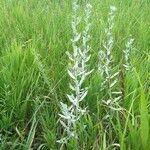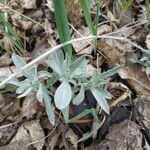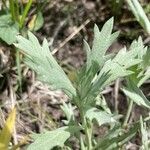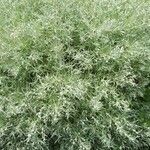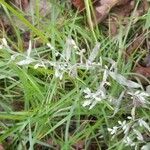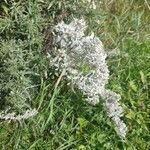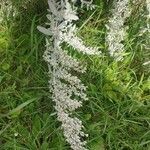Perennials, 20–80 (rarely to 120 in desert washes) cm, aromatic (rhizomatous). Stems relatively few to relatively numerous, erect, gray-green, simple or widely branched, hairy. Leaves cauline, uniformly gray-green, green, or white, or bicolor (white and green); blades linear to broadly elliptic, 1.5–11 × 0.5–4 cm, entire or lobed to relatively deeply pinnatifid, faces hairy. Heads (erect to nodding, peduncles 0 or 2–5 mm) in congested to open (widely branched) arrays. Involucres campanulate or turbinate, (1–)2–4(–5) × 2–5(–8) mm. Phyllaries (gray-green), lanceolate to ovate or obovate (margins narrowly hyaline), densely tomentose. Florets: pistillate 5–12; bisexual 6–45; corollas yellow, sometimes red-tinged, 1.5–2.8 mm, glabrous. Cypselae ellipsoid ca. 0.5 mm, (obscurely nerved) glabrous. 2n = 18, 36, 54.
A perennial herb. It grows 60-120 cm high and 60-90 cm wide. The roots spread easily producing upright stems. The leaves are grey. They are sword shaped and can have coarse teeth. The leaves are densely felted underneath. The flowers are tiny and occur in plumes. They are greyish-white.
